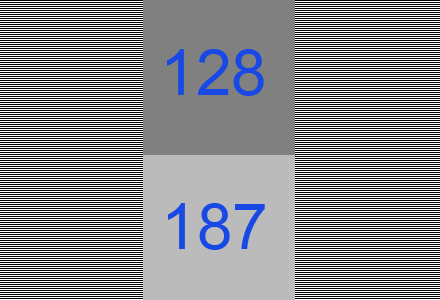Michael Cohen was looking at John Hable’s useful test image:

He noticed an odd thing. Looking at the image on his monitor (“an oldish Dell”) from across the room, it looked fine, the 187 area matched the side areas:

(yes, ignore the moires and all the rest – honestly, the 187 matches the side bars.)
However, sitting at his computer, the 128 square then matched the side bars:

Pretty surprising! We finally figured it out, that it’s the view angle: going off-axis resulted in a considerably different gray appearance. Moving your head left and right didn’t have much effect on the grays, but up and down had a dramatic effect.
Even knowing this, I can’t say I fully understand it. I get the idea that off-axis viewing can affect the brightness, but I would have thought this change would be consistent: grays would be dimmed down the same factor as whites. That last image shows this isn’t the case: the grays may indeed be dimmed down, but the alternating white lines are clearly getting dimmed down more than twice as much, such that they then match the 128 gray level. It’s like there’s a different gamma level when moving off-axis. Anyone know the answer?
Addendum: and if you view the first image on the iPhone, you get this sort of thing, depending on your zoom level. Here’s a typical screen shot – I’ve trimmed off the right so that the blog will show one pixel for pixel (on desktop computers – for mobile devices you’re on your own). This darkening is from bad filtering, see the end of this article.

Follow-up: one person commented that it’s probably a TN panel. Indeed, there’s a video showing the tremendous shift that occurs. The blue turning to brown is particularly impressive. I haven’t yet found a good explanation of what mechanism causes this shift to occur (Wikipedia notes other monitors having a gamma shift, so maybe it is something about gamma varying for some reason). There’s a nice color shift test here, along with other interesting tests.
Even better: check out this amazing video from Microsoft Research. (thanks to Marcel Lancelle for pointing it out)
What is the make/model of the monitor? This could very well be dependant on the panel used as I would generally expect this type of behaviour from a TN panel while an IPS panel would be fine.
Michael says it’s “an oldish Dell,” if that helps. I now want to try this at home with my own monitors (I’m traveling).
For an example you can check https://youtu.be/Kqw_BeFa-hk?t=27s (one of many TN vs. IPS videos) to see how extreme the issue can be.
LCDs from different manufacturers have different Contrast Ratio and Viewing Angle specs. It can affect how you see colour and contrast: http://www.tftcentral.co.uk/downloads/viewsonic_viewing_angle.pdf
I’ve noticed these TN panels effectively change gamma with viewing angle. On mine I can quickly check what gamma changes will do to my content without having to find a UI slider.
TN panels have faster update rates than IPS, so gamers often prefer them. The main challenge is that you can’t put them into portrait orientation because you tend to move more horizontally than vertically.